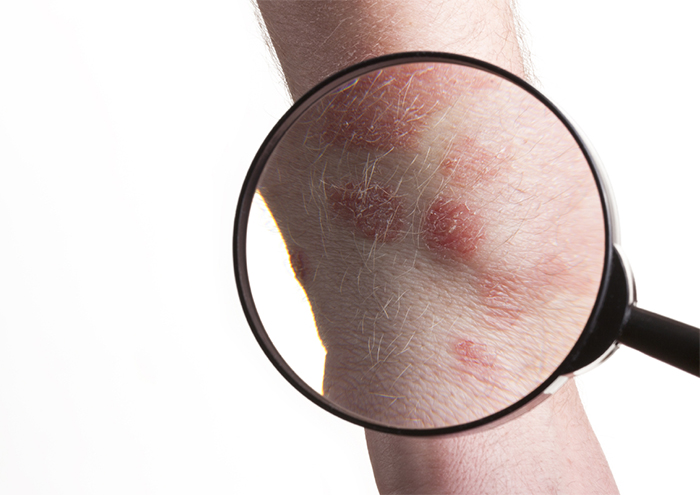In-depth

Let's look at... psoriasis
In In-depth
Bookmark
Record learning outcomes
The needs of psoriasis patients often go unmet as the disease is perhaps not taken as seriously as it should be. How are sufferers affected?

Psoriasis is a long term skin condition in which the body produces skin cells much more quickly than normal. This may not sound particularly serious, but the appearance of the disease as well as some of its complications can cause low self-esteem, anxiety and in some cases even depression. Why psoriasis occurs is not fully understood, but it is thought to be related to the immune system, which attacks healthy skin cells as if they were an infection.
The body produces new cells in the deepest layer of skin and these gradually move up until they reach the outermost layer, where they die and flake off. This process should take between 21 and 28 days in normal skin. However, in psoriasis, skin cells are replaced every few days, causing those that are not fully mature to rapidly build up on the surface and create the thicker patches of skin that are associated with the condition.
Who is affected?
Psoriasis is a common condition that affects up to three per cent of the UK and Ireland population – that’s 1.8 million people. Symptoms can appear at any age, but they typically peak during the late teens to early 30s, and then again between the ages of 50 and 60. Men and women are affected equally. As one in three psoriasis sufferers has a close relative with the disease, there may be a genetic link. However, the precise role that genetics plays is unclear.
What are the symptoms?
The severity of symptoms varies between individuals. For some people, psoriasis is just a minor irritation, while for others it impacts greatly on their quality of life.
The most common form of the disease is plaque psoriasis (around 90 per cent of cases), which produces red, flaky patches with silvery scales on Caucasian skin and darker patches on darker skin types. Patches are usually small and well defined, and although they can appear anywhere on the body, they typically develop on the elbows, knees, scalp and lower back. Other types of psoriasis include:
- Scalp
- Nail
- Flexural (on sensitive areas such as the face)
- Guttate (often triggered by streptococcal throat infection)
- Pustular (which produces pus filled blisters).
Psoriasis generally involves periods of no or mild symptoms, followed by times when symptoms are more severe. This can be due to a trigger, such as:
- Injury to the skin
- Alcohol
- Smoking
- Stress
- Hormonal changes (e.g. puberty)
- Certain medicines (e.g. lithium)
- Throat infections
- Immune disorders (e.g. HIV). Knowing their trigger can help sufferers to avoid flare-ups.
Related conditions
Some sufferers also experience inflammation of the joints, which is known as psoriatic arthritis (PsA). Typically, this condition causes an entire finger or toe to become swollen, rather than an individual joint. Some people also experience pain where tendons meet bones, such as in the lower back, buttocks, chest and heels. Nail psoriasis occurs in around 80 per cent of PsA sufferers and they’re also more prone to eye conditions. Recent research has revealed that people with psoriasis may have a higher risk of developing diabetes and cardiovascular disease (CVD). However, more research is needed to find out why this might be.
How is psoriasis treated?
There is currently no cure for psoriasis, but a range of treatments are available to help improve symptoms. The first treatment choice is often a topical cream, gel or ointment (e.g. containing vitamin D analogues). These are mild, but can be increased in strength if necessary. If topical treatments are ineffective or the condition is severe, phototherapy (which exposes the skin to UV light) may be tried. In very severe cases or when other options have failed, oral or injected medicines may be offered. GPs can prescribe physiotherapy, NSAIDs and steroid injections for the treatment of PsA. In severe cases, rheumatologists may prescribe tablets or injections.
Support for self care
Moisturising the skin with emollients is critical to psoriasis management. It helps to soften plaques, lift scale, reduce itching and redness, and enables effective absorption of the active ingredients in treatments. Emollients are available in a range of formulations, from thick ointments to lighter lotions, sprays, oils and soap substitutes. Customers may have to try a few different products before they find an emollient routine that works for them. Exercise can help to relieve pain in PsA sufferers, and it also reduces the risk of developing CVD and diabetes.
Signposting
The Psoriasis Association offers free information and advice, along with support via virtual forums.
